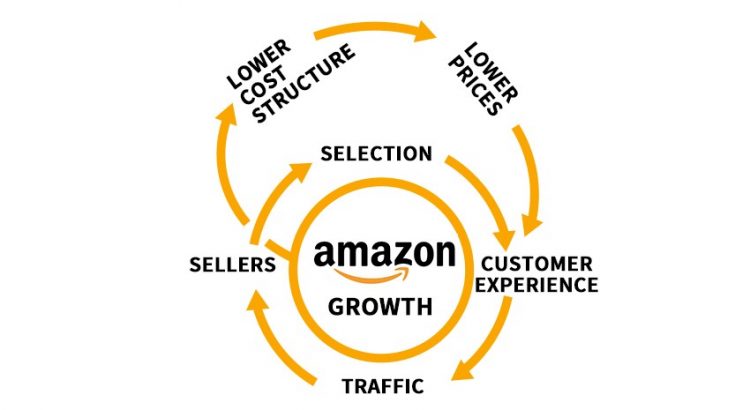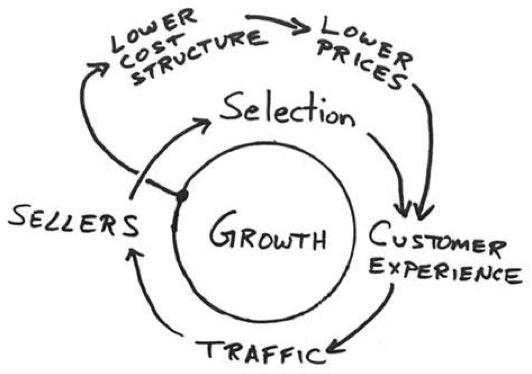How to move the Amazon flywheel: Everything You Need to Know for 2023

While the Amazon flywheel sounds like some sort of ancient machine from the depths of the rainforest, it is actually a fairly straightforward concept that was penned by Jeff Bezos on a napkin when explaining it after he learned about the ‘flywheel effect.’ Amazon’s foundation is based around the flywheel effect, and it is similar to Newton’s First Law of Motion: an object will remain at rest or in uniform motion unless it is acted upon by an external force.
In relation to Amazon, in order to increase the momentum of the wheel of growth, multiple flywheels must be in motion around it: lower prices, more third-party sellers, improving customer service, increasing traffic, attracting more third-party sellers, more selection, lower prices; going on and on, each segment adding their momentum to the wheel of growth to make it accelerate. As each flywheel adds its momentum, growth becomes easier and easier to maintain.
What is the Amazon Flywheel?
The Amazon flywheel is the metaphorical object of growth and everything related to it in order to get its momentum up to speed and make further acceleration easier. The visualization of the process penned by Jeff Bezos is now famous for its simplicity and ease of understanding.
With the basic understandings of the Amazon flywheel, you as a seller can use this knowledge to benefit from the Amazon flywheel’s momentum and power of growth. Being a seller means you are a small flywheel that is helping power the larger wheel that is Amazon.
The Foundation of Amazon
Understanding the foundation of which Amazon is built on can help you further decipher why Amazon and Amazon flywheel has such success:
The first half and most important of the foundation of Amazon is customer experience. Almost everybody that deals with Amazon generally has a good customer experience and Amazon works hard to ensure the customers are happy and return. Some policies, such as changes made to the Amazon third-party sellers’ returns and refund systems, are examples of a focus on customer experience.
The second part of the foundation is that success begets success and is rewarded. For Amazon, efficiencies and costs are what keeps the flywheel momentum going, lowering costs leading to lower prices, leading to growth, leading to lower costs, etc. Amazon’s logistics system is cutting-edge, allowing it to save on costs and ensuring speedy and efficient fulfillment and delivery of products, resulting in investment in more technology, products, and exclusive offerings. For the sellers it’s all about selection, sales and profits (which Amazon gets a share of), so your success as a seller is key to Amazons’ overall success. More sales lead to better rankings and better placement of products, resulting in more sales… and repeat.
The Sellers' Wheel of the Amazon Flywheel
As a seller, your performance on Amazon is important to the growth of Amazon, and your store has its own smaller gears that add to the momentum of your own growth.
To start, you need to provide product listings that are compelling to customers to push conversions and sales. As your sales improve, your product gains rank, and with a better rank, you have better listing placement on Amazon. The more visible your product is, the more sales you make, and momentum for growth starts to accelerate. Good reviews and customer service can help you grow in an organic way, or you can purchase sponsored product ads and headline search ads or run promotions to accelerate your growth artificially.
How to Turn the Amazon Flywheel to Power Profits

There are four main gears you should be focused on when trying to power your businesses' Amazon flywheel and bring in profits.
Discovery: This is the ability for consumers to find your products. There are a few things you can focus on to ensure the Amazon A9 algorithm makes you visible to customers when they are searching for products you have available. Ensure that you use the character limit in titles wisely; you only have 200 characters to work with. Include the product name, the brand name, what it does, and any variations of those that may be searched for.
Your product's bullet points should be easy to read, formatted well, and full of useful information. If you have a warranty or guarantee, tout them in the bullet points. Keywords are important; ensure you pepper the proper keywords throughout your listings: in the title, bullet points, headline, description, and backend.
Traffic: You need consumers viewings your listings to improve your ranking, so you need to find ways to drive traffic. The most common method is using advertising. Wholesalers or brand owners on Amazon Vendor Central or the Vendor Express platform have access to a variety of tools through Amazon Marketing Services (AMS). 3P sellers on the Seller Central Platform have more limited options: sponsored product ads, and headline search ads (limited to brand owners).
Conversion: Once you get consumers to your listings, you need to get your product sold, and that requires compelling details. Put in as much detail as you can about your product and include the story behind your brand to add to the appeal.
You can include nine photos with a product listing, so use them all wisely. Video is a new feature for 1P sellers and will be available soon to brand-owning 3P sellers. Be sure to answer any potential buyers’ questions in the Q&A to give crucial information to them and other consumers. Promotions will help get your name out there and bring in more consumers to buy your products if they run well.
Reviews: Reviews are very important to selling your product as many people will rely on others’ experiences in your store. Product reviews are important, listings with no reviews often look suspect. Positive reviews are often about good customer experiences, so provide a quality product at good prices, deliver it fast, and fix any issues as quickly as possible and you’ll end up with positive reviews in no time. Don’t forget to check your competitors’ reviews to see what has gone wrong with their products so you can fix that in yours if needed.
Keeping the Amazon Flywheel Momentum Up for Continued Success
As mentioned above, getting the Amazon flywheel in motion is the hard part. Once you put in the hard work to get your seller wheel going, it will keep spinning with minimal maintenance. However, don’t get complacent. Changes will occur from time to time (such as policy changes). You need to make sure you are keeping up with the changes in the marketplace so that you can adjust to ensure nothing slows down your flywheel unexpectedly.
Stay informed, seize opportunities, and be quick to act when changes need to be made, and you’ll reap the benefits.
About Tool4seller
A best-in-class Amazon seller tool that is specialized in sales& profits analytics, PPC optimization, keyword research, competitor tracking, instant alerts for listing hijacking, price changing, and inventory updates, etc.


